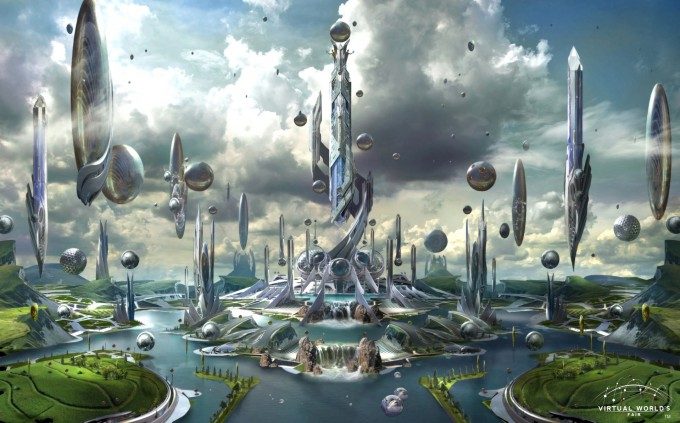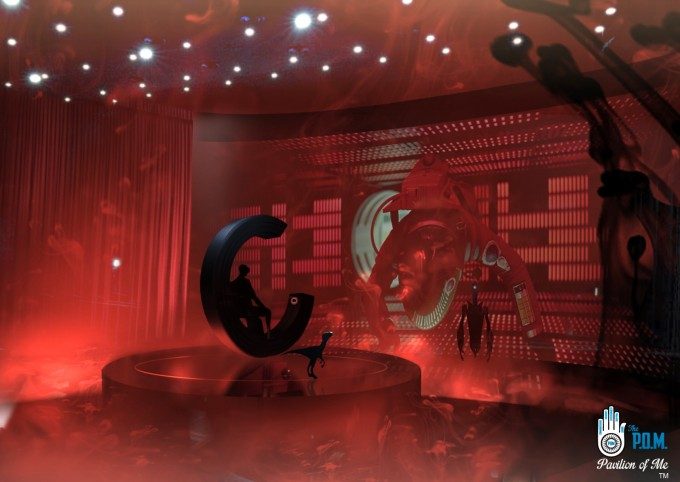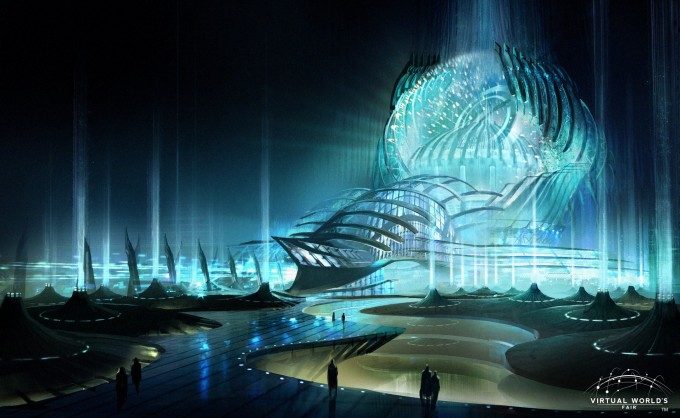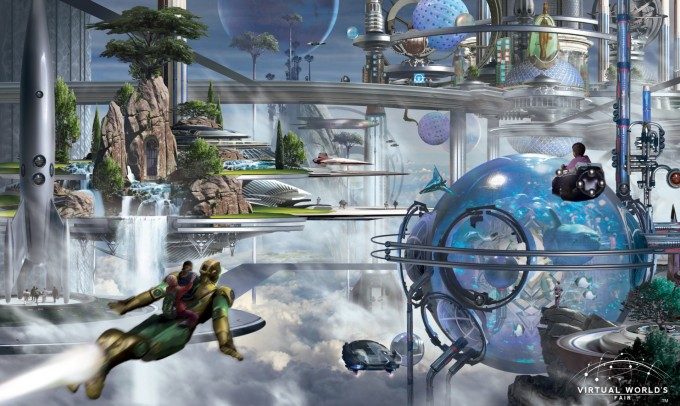Noah Nelson is back with another instalment of Immersion Point and this week digs into Landmark Entertainment’s recent unveiling of their new ‘Pavilion of Me’ project, an immersive content platform designed to be the first step on the road to enticing users into the next generation of VR theme parks.
 Noah Nelson (@noahjnelson) is the head writer of Turnstyle News, a public media website that covers tech and entertainment, and a project of the Peabody Award winning Youth Radio.
Noah Nelson (@noahjnelson) is the head writer of Turnstyle News, a public media website that covers tech and entertainment, and a project of the Peabody Award winning Youth Radio.
With the virtual reality hardware battle nice all heated up it clearly was time for a new war to erupt.
Not AR vs. VR or even the introduction of another head mounted display. Not even Magic Leap’s semi-mythical wondertech that will render all other forms of visual display obsolete. (Not saying that I’ve seen it, just that’s how everyone acts.)
Instead I’m talking about the dreaded P-word. Platforms.
This week Landmark Entertainment Group—a themed entertainment design house in Southern California who made their name by developing attractions like Jurassic Park for Universal Studio’s theme parks—announced that they are working on two new VR projects.
See Also: Landmark are Creating a Virtual Reality Theme Park You Can Enjoy at Home
The big one they’re calling the Virtual World’s Fair— and if that’s evoking the image of a series of interconnected pavilions that showcase experiences from around the world then the folks who name stuff are doing their job right. This “World’s Fair” is in the works, but isn’t scheduled to hit the market until 2017. Landmark isn’t content to hold out for that, so they’ve fast tracked development on a smaller, similarly Fair-themed, experience they’re calling the Pavilion of Me.
Conceptually the P.O.M., as Landmark likes to call it, has some similarities to Playstation Home and Second Life. That is, the P.O.M. is a virtual lounge space/content launchpad that users can customize to suit their tastes.
I recently had a chance to visit Landmark’s offices in Pasadena where CEO Tony Christopher spoke with me, and gave me a VR video walk through of the P.O.M. on an Oculus DK2. While I was there I also got to see the pitch deck Landmark has put together for the World’s Fair.
The video walk through was…well it’s a video walk through. The user is in the center of a spherical room, waited on by an android valet, who for the purposes of the demo is there to act as a guide to the features. Those included photo albums, buttons for Twitter, Facebook, and—in a nice little surprise—an actual Skype session. Not that I’m sure that I want to Skype with someone while I’m wearing an HMD, but seeing someone on the old video phone felt kinda neat in VR.
There were were different “rooms” in the experience aside from the “Communications” launchpad. One was a personal lounge that could be filled with trophies and widgets. The idea is that these could either be earned or purchased through microtransactions. I’d question whether or not there’s a business model in buying virtual stuff to decorate virtual rooms in but hey:League of Legends is a thing and people spend hundreds of dollars on Star Wars trading cards that they can only look at on their phones.
(No, I’m not one of those people. I prefer my Star Wars stuff to be made out of plastic in China. These are the traditions of my people, damnit.)
It’s all rendered in engine, so it’s easy enough to extrapolate what the interactive part of the experience is going to be like. Once controls have been settled on. That’s a hurdle the team hasn’t cleared yet.
There are two big questions here: can Landmark pull this off—interactions and all—and even if they do will there be a market for this kind of thing. Neither is entirely straightforward. Let’s start with the first question: can they pull it off?
Here I’m cautiously optimistic. A fair amount of whether or not the P.O.M. will be compelling and fun is going to come down to what the control scheme is. Seeing a rendered demo was actually somewhat frustrating, as the key thing about VR is its ability to be interactive and this was not that. The idea of a command and control center for interaction in VR is very attractive to me. It’s something I daydream about on a regular basis, but getting a video version of someone else’s take on my own daydream is… well it’s not exactly better than the real thing.
There are, however a few things going in Landmark’s favor.
One is the experience they bring to experience design. I’m going to crib some lines from the press release they put out today:
Pavilion of Me was also inspired by Landmark’s traditional theme park work, borrowing from Landmark’s theme park design concept of ‘play patterns’ to help lay the foundation for mass consumer adoption of virtual reality.
“‘Play Patterns’ refers to the daily behaviors or patterns that consumers exhibit when going about their daily lives,” notes Christopher. “When we conceptualize attractions in the theme park business, we carefully think these patterns through to make sure that the end-to-end attraction experience for consumers is seamless and compatible with those comfortable, natural, daily human behaviors.”
This is the kind of thinking that needs to be happening in the VR space.
Now that’s not me saying that it isn’t happening out there. Just that it needs to be happening. Like all the time. The bet that Landmark is making is that the way they approach designing physical space is going to pay off in the design of virtual space. Only without all those pesky physics and materials costs getting in the way.
The folks at Landmark are basically wizards when it comes to physical design—master illusionists who can use light and paint to turn a hotel shopping row into a Venetian canal. I wouldn’t put it past them to be able to come up with a spatially based content interface. The open ended question remains how users will interact with that virtual space. A beautiful, smartly designed space will be almost as frustrating as a video walk through if seamless controls aren’t there.
Christopher has been dreaming about this stuff for a long time, however, and because of that Landmark is really going hard on VR. The company is recruiting from the gaming world, and one part of the pitch deck I was shown featured gaming guru Warren Spector as part of the team. That’s a real feather in the cap right there.
So the answer to “can they pull it off”—at least as far as the P.O.M. goes? A qualified yes. It really comes down to how good the physical interface—be it some version of Kinect, Oculus Touch, Playstation Move—is.
The harder question is will there be a market for this kind of thing? Or perhaps the real question is how many P.O.M. and Virtual World’s Fair type experiences are going to be out there.
Each of the experiences is intended to be a solution to content discovery. The P.O.M. is a VR desktop, essentially. At this year’s Proto Awards an adaptation of Windows for VR was given a GUI design award. Which, frankly, was ridiculous. The winner noted that he just copy and pasted windows into Oculus. Could that be all people want? All that people are ready for?
There is something wonderfully efficient about our desktop and smartphone file systems. When you know what you want these things are right there waiting for us. Then there are the voice activated assistants—Siri, Cortana and the like—which are helping make search more natural, friendly.
That’s for what we already have.
Discovery remains a problem. For end users it’s a matter of turning up surprises that you might actually care about out of the sea of possibilities. For content creators the problem is standing out in the storm of options. There’s just too much stuff out there online. While Amazon is great at feeding a reader something similar to what they already consume, it’s crappier than a good indie bookstore when it comes to turning up a book you wouldn’t expect to like. There’s something about a physical space that allows for serendipitous discovery. That’s the dream that animating all these pushes for “metaverse” spaces in VR.
What we don’t know is if this kind of discovery will really work in VR, or if two decades of flat design online will make embodied design seem outdated. Personally I’m into the idea… but I’m a weirdo. I like theme parks, malls, and wandering aimlessly in Barnes and Noble. I even poured one out when Borders died. (Okay, it was a latte that had gone cold in my car cup holder, but I still poured it out.)
If it does work then everyone and their mother will be getting into the game of trying to make their own metaverse interface. The ones that are going to matter are the ones that come packed in with the hardware. Christopher knows this. There was a gleam in his eye when he talked about the P.O.M. being a selling point for hardware makers. What isn’t in place yet—at least as far as what’s been shared with me—is a deal that would pack the P.O.M. or the World’s Fair in with a specific HMD platform.

The hardware makers are going to want to control the content launching experience. That platform will be the store from which much—if not everything—that can be played on a device will be purchased. I have a hard time believing that anyone is going to make the mistake that Google did with Android and let a whole host of store models pop up in the initial VR infrastructure. Apple has shown that a unified store is basically a machine that prints money, and you just know that Facebook, Sony, and HTC have all taken that lesson to heart.
Which actually leaves me more bullish on the Virtual World’s Fair, and the potential for a wide open discovery platform for experiences than it does on the Pavilion of Me.
All of this on top of the VR centers that Landmark plans to start opening in 2017. There’s a play here that ties the “out of home” centers to the “in home” Pavilion and Fair. If the exclusive experiences in that ecosystem are compelling enough then the market for the platform would materialize as well.
Which means we’re back to the “killer app” as the determining factor in who will be the winners and losers in the great VR war to come. A platform will be a great thing to have for whoever does make the killer app, but a platform alone won’t make a titan of VR.
That being said: do I want to see Landmark’s full skills come to bear on a virtual environment? Hell, yes. I’m just more interested in their storytelling and spatial chops being used to develop narratives and discovery spaces than in the chance Christopher and company will build a better mousetrap.
They’re not wrong to see the critical component in the VR space being the content interface, it’s just going to be one ugly, vicious fight to control that piece of the chessboard. In both video delivery and gaming platforms are only as good as the exclusive content they have wrapped up in them. Look at Netflix, Steam, or even EA Origin for examples.











